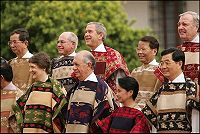
Chamanto
Encyclopedia

Chile
Chile ,officially the Republic of Chile , is a country in South America occupying a long, narrow coastal strip between the Andes mountains to the east and the Pacific Ocean to the west. It borders Peru to the north, Bolivia to the northeast, Argentina to the east, and the Drake Passage in the far...
, similar to a poncho and woven in silk
Silk
Silk is a natural protein fiber, some forms of which can be woven into textiles. The best-known type of silk is obtained from the cocoons of the larvae of the mulberry silkworm Bombyx mori reared in captivity...
thread and wool
Wool
Wool is the textile fiber obtained from sheep and certain other animals, including cashmere from goats, mohair from goats, qiviut from muskoxen, vicuña, alpaca, camel from animals in the camel family, and angora from rabbits....
. Its entire contour is finished with ribbon edging. The difference between a chamanto and other ponchos is their reversibility, as both sides — one light, one dark — are fully finished. Traditionally, the dark side of the poncho is used during the day, while its light side is mostly worn at night.
The chamantos gained world attention when they were worn by the 21 leaders of the Asia Pacific Economic Cooperation during the 2004 summit's official photo.
The making of a chamanto demands great diligence, because of the exquisiteness involved in the weaving of the silk and wool, plus the intricacy of the design sketched by crossing the threads.
The figures embellishing the chamantos include copihue
Copihue
Lapageria rosea, commonly known as the Copihue Lapageria rosea, commonly known as the Copihue Lapageria rosea, commonly known as the Copihue (co-pee-way Lapageria rosea, commonly known as the Copihue (co-pee-way...
s —Chile’s national flower— barley
Barley
Barley is a major cereal grain, a member of the grass family. It serves as a major animal fodder, as a base malt for beer and certain distilled beverages, and as a component of various health foods...
and wheat
Wheat
Wheat is a cereal grain, originally from the Levant region of the Near East, but now cultivated worldwide. In 2007 world production of wheat was 607 million tons, making it the third most-produced cereal after maize and rice...
ears, blackberries
Blackberry
The blackberry is an edible fruit produced by any of several species in the Rubus genus of the Rosaceae family. The fruit is not a true berry; botanically it is termed an aggregate fruit, composed of small drupelets. The plants typically have biennial canes and perennial roots. Blackberries and...
, bunches of grape
Grape
A grape is a non-climacteric fruit, specifically a berry, that grows on the perennial and deciduous woody vines of the genus Vitis. Grapes can be eaten raw or they can be used for making jam, juice, jelly, vinegar, wine, grape seed extracts, raisins, molasses and grape seed oil. Grapes are also...
, fuchsia
Fuchsia
Fuchsia is a genus of flowering plants that consists mostly of shrubs or small trees. The first, Fuchsia triphylla, was discovered on the Caribbean island of Hispaniola in 1703 by the French Minim monk and botanist, Charles Plumier...
s, pansies
Pansy
The Pansy is a large group of hybrid plants cultivated as garden flowers. Pansies are derived from Viola species Viola tricolor hybridized with other viola species, these hybrids are referred to as Viola × wittrockiana or less commonly Viola tricolor hortensis...
and various birds representative of the national fauna.

